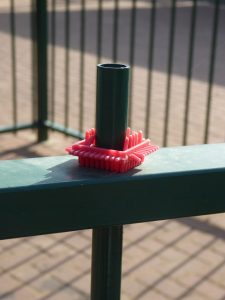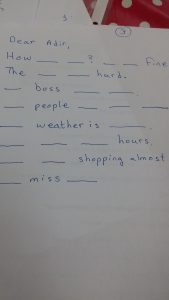This is part two of my second blogging challenge, in which I experiment with and reflect on some of the small changes recommended in John Fanselow’s “Small Changes in Teaching, Big Results in Learning” . These challenges are a way for me to keep honing my teaching skills.

Naomi’s Photos
I had heard of “Read and Look Up” before encountering this book, but never tried it in class. The rationale for having the students not recite a text mechanically while reading it from the page is clear and simple, that wasn’t what stopped me from trying it. It’s intuitive too, I can feel it on myself – a person can’t really focus on comprehension and process the vocabulary, syntax and content presented in a text while focusing on reading aloud, particularly in a foreign language. It’s perfectly possible to read aloud from a page nicely without understanding what you have read.
What I hadn’t understood at all before reading Fanselow’s explanations and suggested activities is that reading a sentence (or two) silently, pausing and then looking at someone before saying the words is not simply an exercise in memory and parroting! Now that I had something concrete to “hold on to”, I started trying some of the variations presented in the book , inventing additional variations along the way to suit my own students.

Naomi’s Photos
The “Advanced” Student – An Individual Lesson
10th grade student, top-level, hard of hearing, but in a quiet, one-on-one setting, can hear fairly well with her hearing aids. She speaks clearly too.
I gave the student, whom we’ll call R., an unfamiliar text written as an opinion essay on whether high school should be required to volunteer in the tenth grade or not. I had no idea if the activity I was going to try was suitable for such a strong student as R. ,but this was a text I had wanted to use in any case. I gave R. no explanations, just asked her to read to herself a sentence or two, turn over the page and say what she read.
R. did as I asked.
She replaced some words with others as she spoke.
I was delighted!
I praised her, explaining that replacing words was wonderful and told her that I wanted us to examine together what exactly she was doing. I pulled out scrap paper and a pen and asked R. to begin again and wrote down every word she said. The situation amused R. – she was speaking and I was the one writing furiously.
We paused after every two sentences (more or less) to compare what R. had said with the original text. We noted which words she had replaced with others and whether they meant the same as the original or not. If not, I suggested other words she could have used. For example, she said “In the beginning” instead of “At first”, which is great. When she said “the experience has donated far more to me” instead of “contributed” we discussed the difference between the two words.
Then R. read (with page turned over, remember?) two long sentences verbatim. She hadn’t replaced a single word or omitted a single one. R. then looked at the text and asked:
” I used the words in the text. I don’t know other words to use here. Can you tell me?”
Needless to say, I was happy to oblige.

Naomi’s Photos
“The Struggling Learners” – Individual Lessons
12th grade students, hard of hearing / Deaf students who use sign language in addition to speech, their speech is not always clear, all have additional learning disabilities, poor language skills in their mother tongue. These students are practicing for the writing section on their upcoming “Module C” final exam, which for them is a very simple, informal letter, 35-40 words long. It is a difficult task for them.
I gave each student a sample letter we had used in class before. The students are already familiar with the format – their final exam is in three weeks! Once again I first had the student look at the text, flip over the page and then read aloud. The texts are short! I wrote what each student said and then we compared it to the original. But then (following Fanselow’s suggestion) I added stages.
Each student received the text again with a blank space instead of one word in each sentence. They had to look at that text before flipping over the page and reading aloud complete sentences. Once again I wrote what they said and we compared what I wrote with the page with the blank spaces.
Then I gave the students the same text again with more blank spaces. They looked at it and repeated the process. When we compared the results to the page not one student asked for the original complete text, they didn’t need it.

Finally I gave the students a blank page and had them write a complete letter on their own.
It’s interesting to note that I hadn’t expected any of the students to replace any words, as their vocabulary is poor.
But they did. A little bit.
I’ve told these students repeatedly to choose adjectives they remember so as not to use the dictionary much on this section of the exam – they really don’t have time. But some students are “stubborn” – one student always wants to write that her boss is mean but can never remember the word “mean” and has to look it up. Today she simply replaced the word “mean” with “nice”!

Notes so far:
*The students and I are really enjoying this.
* In the next post I’ll share my “Read and look up” experiences so far with pair work.
* In Fanselow’s book the teacher isn’t the one doing the writing but for now, at least, that tricky with my students who don’t hear each other well.
* There are more elements to the method in the book.